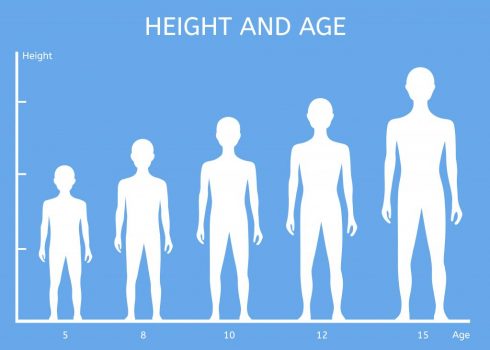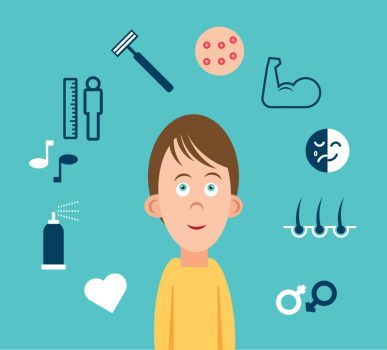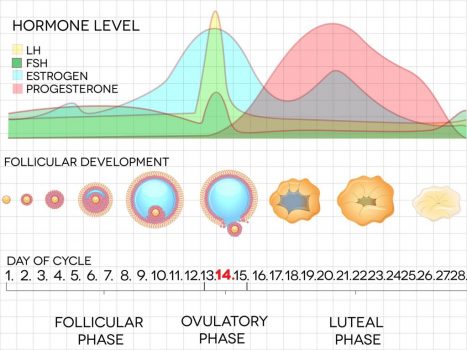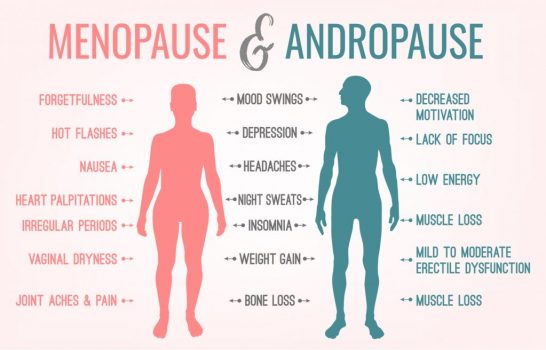
Puberty

Puberty Objectives
-
Describe physical changes that occur to both genetic female and male children during puberty.
-
List the reproductive organ changes that occur during puberty.
-
Define menopause and andropause and describe how it relates to hormones.

When you mention “puberty” to many people, the instant response is negative. People often recall acne and awkward events. In this section, we’ll try to re-frame this significant life event
This video starts an introduction to another way to view puberty, as a series of impressive body changes that start at the cellular level.

In both males and females, hormonal changes at puberty trigger a growth spurt, redistribution of fat, increased metabolism, increased oil gland activity and a myriad of other effects.
Next we will examine the changes that differ between genetic male children (having an X and a Y chromosome) and genetic female children (two X chromosomes). In both cases, there are significant changes associated with reproduction.

In boys, changes in the brain at the start of puberty cause an increase in androgens, specifically testosterone. Notable impacts include changes in the scrotal sac that hold the testes, hair growth, changes in voice, and changes in behavior.
This video highlights some of the changes that occur in boys.

In girls, changes in the brain at the start of puberty start an increase and cycling of hormones that eventually triggers egg maturation in ovaries. Similarly, hormones trigger breast growth, including the lobules that may eventually produce milk.
This video shows some of the changes that occur in girls during puberty.

In a way, menopause is like the reverse of puberty in women. Estrogen production declines, and even if eggs were still present, there are typically no longer sufficient hormones to support egg maturation or implantation of a blastula.
Men also have a decline in testosterone, but it is much more gradual than the drop in estrogen in women. Some research supports the idea of an andropause phase in men, but more research is being done into the resulting relationship to aging and disease.

Life stages have a personal component, but they are also shared by generations of humans. Puberty is a multi-year process that enables individuals to reproduce and pass on their genetic material and personal knowledge. Menopause and andropause often earmark a transition from reproductive life to other pursuits.
Start Your 7B Media Assignment here
Science is limited to observable phenomena, meaning there needs to be direct or indirect evidence that something has occurred. Direct evidence is what you collect with your own senses; indirect evidence is an artifact of something that happened in the past like a photo or a fossil. In this assignment you are collecting and assembling indirect evidence of life stages.

Step #1: Collect evidence of life stages.
This includes reproduction/pregnancy, infancy/childhood, puberty, adulthood, and/or aging. This could be evidence of your own life or someone you know like a family member, friend or community member. You could select a single life stage or show a breadth of life stages. Examples of evidence include photos, receipts, clothes, writing, awards, school items, products, and much more.
Step #2: Assemble the forms of evidence into a form that tells a story.
Many researchers work with artifact (object) evidence and their selection and arrangement of evidence is used to convey information. Arrange your artifacts/evidence to convey a message. It could convey science knowledge, information about your personal life stages, and/or make a more general point about human experience.
You are turning in:
A. A photo or video of your assembled life stage evidence.
B. A description of the message you are trying to convey. This could be in writing, captioning on photos, or in a video.
The next section is a look at the impacts of aging on human health.

Check your knowledge. Can you:
-
describe physical changes that occur to both genetic female and male children during puberty?
-
list the reproductive organ changes that occur during puberty?
-
define menopause and andropause and describe how it relates to hormones?






